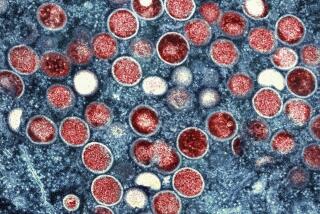What All Those Archaic Medical Terms Really Mean
- Share via
You don’t hear people groaning about their lumbago these days. Why is that? Did we miss some biomedical breakthrough or have people just gotten more stoic?
Lower back pain, however, has reached epidemic proportions.
Sorry, no free L.A. Times tote bags for anyone astutely pointing out that lower back pain and lumbago are one and the same, the latter being an old-fashioned term for the former. (The back, after all, has lumbar vertebrae in it.) But as a consolation prize, we’ll direct you to a Web site that will give you more obscure and old-fashioned names for diseases than you can shake a stick at. Check it out at https://www.gpiag-asthma.org/drpsmith/amt1.htm.
Genealogy enthusiasts, pay attention. This is the site that could finally reveal what really afflicted great-aunt Millie, who had “green fever,” or great-great-uncle Bert, who was lucky enough to die of “natural decay.” Or what was up with my grandfather, who, I was informed, had “neurasthenia,” which means “weakness of the nerves.” (On second thought, Grandpa’s condition is still a bit of a mystery.)
Here’s a sampling of the archaic medical terms that are listed at the site, which was put together by Paul Smith, a British doctor. (There’s more discussion about old-fashioned disease names at https://www.genealogy.com/genealogy/64_donna.html.)
* Trench fever, ship fever or jail fever: all names for typhus, based on where people tended to catch it--crowded and dirty places where body lice thrive. Typhus was also called hospital fever, after probably the last place on earth you’d want to be (in days of yore) if you wanted to stay healthy.
* Marsh fever and jungle fever: terms for malaria, which is transmitted via mosquito bites.
* Grocer’s itch: a skin complaint caused by mites in flour and sugar.
* Whiteblood: leukemia.
* Green fever: anemia.
* Suffocative breast pang: angina.
* Ablepsia, ablepsy and abopsia: blindness. (Don’t ask us why.)
* Grog blossoms: sounds lovely but is in fact less so, being pimples on the nose.
* Unwell: possibly a term for a woman who was menstruating.
* Scrivener’s palsy: writer’s cramp. Seems repetitive stress injury has been around for a while.
* Milk leg: deep vein thrombosis in the thigh, seen after childbirth. Doctors used to think it was caused by milk being misdirected down the leg.
* Phossy jaw: a nasty disease that people working in match factories were prone to get. The phosphorus in the matches ate away at their jawbones.
* General paralysis of the insane: syphilis of the brain. Smith says he receives more inquiries about this term from genealogists than any other on his list.
Report Suggests Link Between Virus, Obesity
Modern biomedicine, meanwhile, is finding out more and more each day about what makes people fat. There’s been a bulge of research papers on the topic of late, albeit for the most part involving little rodents. But hey, as those genome folks often remind us, we’re practically mice.
Definitely the wildest recent report: Some scientists wonder if a virus can make people portly. Writing in this month’s issue of the International Journal of Obesity, University of Wisconsin scientists report infecting chickens and mice with a type of human virus called Ad-36. The inoculated animals got fatter than control animals that weren’t exposed to the virus.
Though the whole thing sounds rather strange, obesity scientists aren’t dismissing out of hand the idea that some human plumpness, at least, could be virus-associated. After all, we never imagined once upon a time that ulcers could be “caught” from a germ--and now we know that most are.
If it is a virus, maybe it’s food-borne?
*
Booster Shots runs every Monday. If you have a possible item, write or e-mail Rosie Mestel at L.A. Times, 202 W. 1st St., L.A., CA 90012 ([email protected]).






